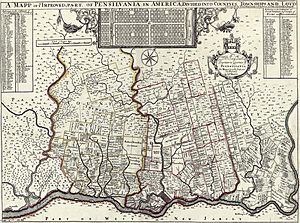Welsh Tract facts for kids
The Welsh Tract, also known as the Welsh Barony, was a special area of land in Pennsylvania, United States. It was mainly settled by Welsh-speaking Quakers. This area is located just west of the city of Philadelphia. The first settlers, led by John Roberts, talked with William Penn in 1684. They wanted the Tract to be its own county where the local government would use the Welsh language. This special "Barony" was never officially created. However, many Welsh settlers gave their communities Welsh names, and these names are still used today. A similar attempt to create a Welsh-speaking colony happened two centuries later in Patagonia, Argentina.
How the Welsh Tract Began
In the late 1600s, many Welsh people moved to Pennsylvania. They came for religious freedom and to keep their culture alive. Around 1681, a group of Welsh Quakers met with William Penn. They wanted a large piece of land where they could manage their own affairs in their own language.
They agreed on a huge area of land, about 40,000 acres (160 square kilometers). This land was supposed to become a separate county. The people and government there would be able to use the Welsh language.
William Penn even wrote a letter about this agreement in 1684. He said that many Welsh Friends wanted all the land they bought to be together as one "Barony." He agreed to this because he wanted to help them. He asked for the land to be laid out neatly on the west side of the Schuylkill River.
The Dream That Didn't Quite Happen
The borders of the Welsh Tract were set in 1687. But even with the agreement, by the 1690s, the land was divided. It became part of different counties. The Welsh settlers tried to stop this, but the Tract never became its own self-governing area.
Even so, Welsh families like the Roberts family became very important in the area. They built mills and later helped bring the railroad. The railroad is why a famous part of the area is now called the Main Line. This name comes from the main railway line of the Pennsylvania Railroad.
After the American Civil War, 104 Welsh families from this region moved to Knoxville, Tennessee. They created a strong Welsh community there too.
As cities grew westward from Philadelphia in the late 1800s, living in a community with a Welsh name became popular. Some towns in the old Welsh Tract were given Welsh or Welsh-sounding names. This made them seem more desirable. For example, Gladwyne was once "Merion Square." It got its new name in 1891, even though the name doesn't mean anything in Welsh. Bryn Mawr was called "Humphreysville" before it was renamed in 1869.
Welsh Names Still Around Today
Today, the area that was once the Welsh Tract is part of Montgomery, Chester, and Delaware counties. Many towns there still have Welsh names.
Some towns are named after places in Wales, like North Wales, Lower Gwynedd, Upper Gwynedd, Lower Merion, Upper Merion, Narberth, Bala Cynwyd, Radnor, Berwyn, and Haverford Township. Other towns have independent Welsh names, such as Tredyffrin and Uwchlan.
In 1701, William Penn also gave another "Welsh Tract" of about 30,000 acres (120 square kilometers) to Welsh immigrants. This area makes up modern Pencader Hundred, Delaware, and some of Cecil County, Maryland.


